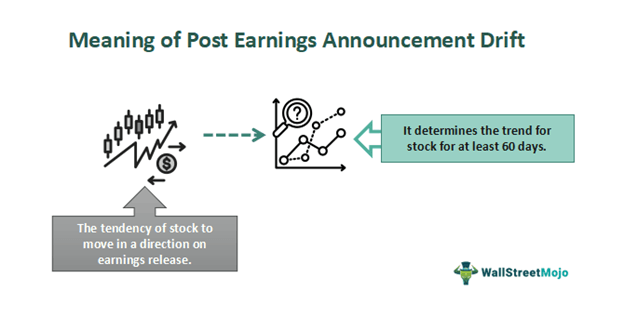Table of Contents
What Is Post Earnings Announcement Drift (PEAD)?
Post earnings announcement drift refers to the market situation moving in a certain direction after absorbing earnings-related company news. It is a crucial phenomenon in the stock markets. The stock follows a certain trend for several weeks after the earnings announcement.

In finance, the post earnings announcement drift anomaly is also referred to as the SUE (Standardized Unexpected Earnings) effect. It measures the immediate effect of these earnings news on company stocks. Also, it determines the direction of the trend, whether upward or downward. However, various factors influence PEAD to varying degrees.
Key Takeaways
- Post earnings announcement drift refers to the trend created in the stock price due to the market reaction to the earnings announcement on the abnormal returns.
- It was first introduced in 1968 by researchers Ball and Brown in the article An Empirical Evaluation of Accounting Income Numbers. It considers the correlation between earnings and stock reactions.
- It is also known as the SUE effect and measures the drift in the stock trend for at least 60 days.
- If the earnings results are positive, the drift of abnormal returns is upward. However, negative results can cause a downward trend in the stock price.
Post Earnings Announcement Drift Explained
Post earnings announcement drift is a market phenomenon of creating a drift in the stock trend after absorbing the earnings-related news. It creates a sort of divergence in the abnormal returns of the stock for several weeks. The earnings announcement leads to an uneven change in the stock trend for almost sixty days. So, if a company delivers a positive result in any quarter, the effect is seen in the stock trend. Moreover, it is also referred to as the granddaddy of underreaction events.
The origin of the post earnings announcement drift trading strategy dates back to the mid-20th century. In 1968, researchers Ray John Ball and Philip Brown proposed the concept in the paper An Empirical Evaluation of Accounting Income Numbers. It recorded the relationship between earnings and stock reactions. Later, more than 1000 post earnings announcement drift papers were published on the same. However, the main aim of all papers focused on how earnings, including surprises, affect the company's valuations.
If the company announces positive earnings, abnormal returns tend to show an upward trend (drift). In other words, company stocks move in a bullish direction. Likewise, a company with negative results can lead the stock and abnormal returns to drift downwards. Here, the drift is measured for at least 60 days and can extend beyond this period.
This PEAD strategy can also be applied to different firm sizes. However, the magnitude of the abnormal returns has an inverse relationship with the firm size. The concept of a post-earnings announcement drift trading strategy is adaptable to various firm sizes. However, the extent of abnormal returns inversely correlates with the size of the firm.
Examples
Let us look at some examples to comprehend the concept better:
Example #1
Suppose Samuel owns a company, "HUSKUN Ltd," that operates in the telecom industry. For the past few years, the firm has earned massive growth in its business. As a result, they currently have a large market capitalization. However, a major impact is visible in the upcoming weeks. Next month, Samuel and the board decided to release the quarterly results of the company. And this time, the financials performed well in the third quarter.
Thus, when HUSKUN Ltd announces its quarterly earnings, the market drops by 10%. By this time, the market had already absorbed this information, and investors had sold some of it. As a result, there is an abnormal drift observed in the stock price from $316 to $284. This downfall lasts for around 70 days. However, the trend reverses in the later stages with partnership deals.
Example #2
Another application of post earnings announcement drift paper states how portfolio returns are affected by these surprises. For instance, James invests in a technology-based company that has recently announced last quarter results. This time, the firm sees a massive growth in sales. As a result of the announcement, investors became more lucrative and bought more stocks, which indeed led to a bullish trend. And James can book around $300 as profit in this scenario.
Importance
PEAD has a realistic approach to defining the behavior of the equity markets. It tries to understand the influence of earnings on the market participants and the factors associated with it. Also, there is management's tone change post earnings announcement drift and accruals. So, let us understand the significance of PEAD in different contexts:
- Impact on the stock prices of non-announcing firms or peers: The major influence of PEAD is visible in the stock prices of other firms, which may belong to the same industry or peer group. For instance, if a company announces quarterly results, the consequential impact also occurs in other stocks in the same industry. Investors typically expect similar firms to exhibit similar behaviors. Consequently, the PEAD of a company plays a crucial role in determining the movements of its peers.
- Determines the trend of abnormal returns: PEAD determines the trend or direction of abnormal returns of a stock. They serve as a tool to predict the future trend of the stock for the next 60 days. Therefore, positive earnings result in an upward trend, while negative earnings lead to a downward trend. Additionally, the manner in which earnings are communicated can also impact the rate of abnormal returns.
- Helps in curating risk management strategies: With the use of PEAD, investors can easily strategize their portfolios in advance. It helps them identify the potential risks that may arise with a company's earnings and trade.
- Mitigation of information uncertainty: It is possible to reduce the uncertainty of certain information with post-announcement earnings. In short, the latter acts as a wiper to mitigate the doubts created among the users with incomplete information.
